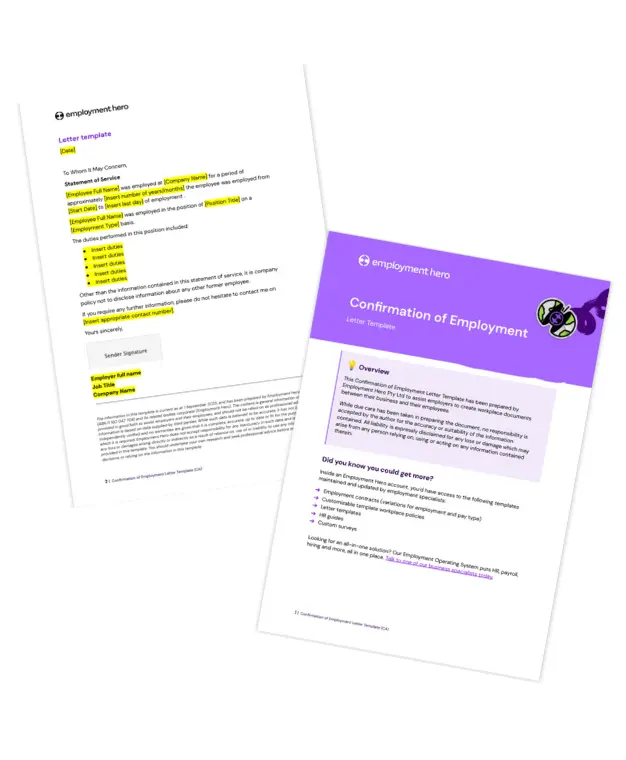Employment verification letter template for Canadian employers
Published
Employment verification letter template for Canadian employers
Published
An employment verification letter (also known as a confirmation of employment letter or statement of service) is a formal document issued by an employer to officially confirm an individual’s employment history, status and income. It is a simple but critical piece of documentation that validates an employee’s claims to third parties.
This letter generally implies that the information provided, for example: job title, start date and current status,is accurate and endorsed by the employer.
This article provides a comprehensive guide to understanding and creating this essential document. Most importantly, we offer a free, downloadable employment verification letter template designed for Canadian employers to help you issue official, concise and professional statements of service efficiently and accurately.

Why an employment verification letter is needed
In Canada, an employment verification letter is frequently requested to satisfy the due diligence requirements of various institutions. Issuing a clear and accurate letter helps your employees access essential services and opportunities.
Securing rental housing
Landlords and property management companies often require a confirmation of employment letter to verify an applicant’s stable income and ability to pay rent before approving a lease agreement.
Mortgage and loan applications
When applying for significant financing, such as a mortgage, car loan or line of credit, Canadian banks and financial institutions will ask for an employment letter to assess the applicant’s financial stability and creditworthiness.
Immigration and visa applications
For temporary or permanent resident applications, including work permits, spousal sponsorships and express entry applications, Canadian immigration authorities (IRCC) require official employment verification to confirm work history and job offers.
Government benefits and services
Employees may need a statement of service to access certain government programs, benefits or subsidies, which require proof of current employment and income level.
Key components of an employment verification letter
To be useful and professional, an employment verification letter must clearly and accurately include the following details:
- Date of issuance: The current date the letter is prepared.
- Recipient information: A general address (e.g., “To Whom It May Concern”) or the specific name and address of the requesting party (e.g., a bank).
- Employee full name: The full legal name of the employee.
- Company information: The official name and address of the employer.
- Employment period: The specific start date of employment. If the employee is a former staff member, the last day of employment should also be included.
- Job title and status: The employee’s formal position title and their employment type (e.g., full-time, part-time, contract or seasonal).
- Brief list of duties: A concise summary of the main responsibilities of the position. This is often crucial for immigration purposes.
- Contact information: Name, title and direct contact details (phone number) of the employer representative who can verify the information.
- Policy statement (optional but recommended): A line indicating that the company’s policy limits the disclosure of any additional information.
Download our free employment verification letter template
Streamline your HR processes with our professional, editable template. Our employment verification letter template is a clean, fully customizable Microsoft Word document designed for efficiency.
Here’s a preview of the employment verification letter or confirmation of employment letter template that you can download:rmation, protecting your business while treating your employees with respect.

Understanding the process of issuing an employment verification letter
Issuing an employment verification letter should follow a clear, professional protocol to ensure consistency and speed:
- Employee request: The process begins when an employee submits a formal request, usually to the HR department or their manager, stating the required information and the intended recipient (e.g., a bank, landlord or IRCC).
- Information gathering: The employer verifies the employee’s details (start date, job title, duties, etc.) using official company records, ensuring accuracy.
- Drafting the letter: The designated HR or management staff drafts the letter using the official company letterhead and our template, ensuring it is dated and signed by an authorized signatory.
- Authorized signature: The letter must be signed by an individual with authority to verify employment (typically HR, Payroll or a Senior Manager).
- Delivery: The completed, signed letter is provided to the employee in a secure manner (often as a PDF) or sent directly to the requesting third party, as stipulated by the employee’s request.
Important considerations for employment verification
When issuing a statement of service, employers must be mindful of a few key elements to protect both the employee and the company.
Clarity and accuracy
The information provided must be 100% accurate. Discrepancies in job title or dates could cause issues for the employee (e.g., delaying a loan approval) or open the employer up to liability if the information is intentionally misleading.
Professionalism
Always issue the letter on the official company letterhead. Use a formal, direct tone and ensure the letter is signed by an appropriate individual. A professional letter confirms the validity of the document.
Legal and privacy aspects
Employers should generally limit the information disclosed to the basic facts of employment (dates, title, duties, salary/income if requested and authorized). Do not disclose performance information, reasons for termination or any confidential personnel data without explicit, written consent from the employee, as this can violate privacy legislation.
Salary and income verification
If a third party requires income verification (common for loans), the employer should only provide the requested income details (e.g., annual salary or hourly wage) if the employee has given express written permission for this specific data to be shared.
Ready to download our customizable template?
A well-drafted employment verification letter is a valuable service that employers provide to their staff. It helps employees secure necessities like housing and financing while ensuring your company is represented professionally and compliantly. Using a reliable template ensures the swift and accurate issuance of this critical document every time.
Frequently asked questions
The most frequent requesters are banks and mortgage lenders, landlords, Canadian immigration services (IRCC), government agencies for benefits and potential future employers.
While there is no blanket legal requirement to provide employment verification in Canada, it is generally considered a standard, professional courtesy. Refusing without a valid reason can harm an employee’s opportunities. However, employers have the right to limit the type of information disclosed to protect privacy.
Most HR departments aim to process an employment verification letter within 3 to 5 business days of receiving a formal request. It is often faster if the employer uses a standard template like ours.
It is primarily done through a formal, written employment verification letter on company letterhead. Increasingly, some large organizations use automated third-party services that the requester can contact directly.
If the employee knows the specific recipient (e.g., “XYZ Bank, Mortgage Department”), address it directly. Otherwise, it is standard practice to use the general salutation: “To Whom It May Concern.”
The information in this template is current as at 1 September 2025, and has been prepared by Employment Hero Pty Ltd (ABN 11 160 047 709) and its related bodies corporate (Employment Hero). The content is general information only, is provided in good faith to assist employers and their employees, and should not be relied on as professional advice. Some information is based on data supplied by third parties. While such data is believed to be accurate, it has not been independently verified and no warranties are given that it is complete, accurate, up to date or fit for the purpose for which it is required. Employment Hero does not accept responsibility for any inaccuracy in such data and is not liable for any loss or damages arising directly or indirectly as a result of reliance on, use of or inability to use any information provided in this template. You should undertake your own research and seek professional advice before making any decisions or relying on the information in this template.
Register for the template
Related Resources
-
 Read more: Protect Your Business and Stay on Pace: The Top 5 Holiday Party Legal Risks to Watch For
Read more: Protect Your Business and Stay on Pace: The Top 5 Holiday Party Legal Risks to Watch ForProtect Your Business and Stay on Pace: The Top 5 Holiday Party Legal Risks to Watch For
Before the festivities begin, learn how to manage alcohol, conduct and inclusivity to keep your workplace safe and compliant through…
-
 Read more: Employee onboarding Canada: How to set up the first 90 days for success
Read more: Employee onboarding Canada: How to set up the first 90 days for successEmployee onboarding Canada: How to set up the first 90 days for success
Learn how to create an effective employee onboarding plan. Explore a 30-60-90 day framework, compliance requirements and strategies for long-term…
-
 Read more: Optimizing Your Capital Stack: How Grants, SR&ED, and Financial Strategy Fuel Startup Growth
Read more: Optimizing Your Capital Stack: How Grants, SR&ED, and Financial Strategy Fuel Startup GrowthOptimizing Your Capital Stack: How Grants, SR&ED, and Financial Strategy Fuel Startup Growth
Join Employment Hero, Grant Solutions Canada and BrightIron to learn how grants, SR&ED and smart capital strategy fuel sustainable startup…

















